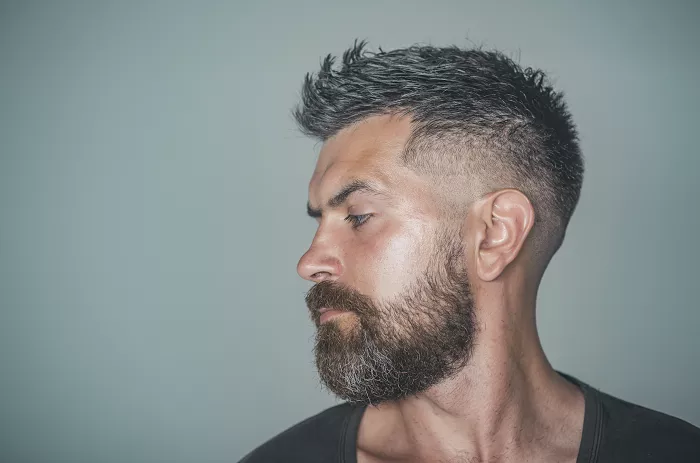Beard transplants are quickly becoming one of the hottest trends in men’s cosmetic procedures. Once a symbol of rugged masculinity, a full, thick beard is now a sought-after trait, driving a surge in beard transplant procedures globally. In the past month alone, searches for “beard transplant” have increased by 19%, with a 600% spike in interest for “beard transplant Turkey,” reflecting the growing demand for affordable facial hair enhancements. But before booking your transplant, there are several important factors to consider.
What is a Beard Transplant?
A beard transplant is a specialized hair restoration procedure designed to create fuller, denser, and more natural-looking facial hair. Unlike other cosmetic treatments, beard transplants have become about more than just aesthetics—they’re now tied to identity and self-expression. The rise in popularity of this procedure comes as facial hair has gained cultural significance in expressing masculinity.
Men experiencing sparse beard growth or visible gaps often face frustration and decreased confidence. Dr. Balwi notes that these issues can go beyond physical appearance and affect a man’s social life. A beard transplant can address these concerns by filling in gaps and creating a more even, natural-looking beard.
Why Are Men Opting for Beard Transplants?
Cosmetic surgery among men has become more socially acceptable, and the demand for facial hair restoration is on the rise. Online forums such as Reddit’s “beards” community, which boasts over 1.2 million members, reveal how common beard insecurities are. Many of these men are turning to hair transplants as a solution.
Clinics in countries like Turkey have capitalized on the demand for affordable, overseas treatments. While these “transplant tourism” destinations offer discounted packages, experts warn that going abroad may come with risks. Dr. Farjo cautions that many foreign clinics may not meet the same regulatory standards as those in the UK. Hygiene, aftercare, and the qualifications of the performing surgeon are major concerns when booking low-cost procedures overseas.
How to Choose a Legitimate Clinic
Before booking a beard transplant, Dr. Farjo recommends thorough research. Make sure the surgeon is properly qualified and affiliated with recognized professional bodies like the International Society of Hair Restoration Surgery (ISHRS). Always ask for the surgeon’s credentials and experience, and insist on an in-person consultation before proceeding with the treatment.
In the UK, you can verify a clinic’s credibility by checking if it’s registered with the Care Quality Commission (CQC). Clinics registered with the CQC must meet strict patient safety, cleanliness, and staffing requirements. This registration offers added peace of mind that the clinic is regulated and accountable.
Another red flag to watch out for is the use of unqualified staff. Many clinics are hiring non-medical technicians under minimal supervision to cut costs. Dr. Farjo warns that this could compromise patient safety. Always inquire about who will perform each part of the procedure and their qualifications.
What Does the Procedure Involve?
Beard transplants typically use two methods: Follicular Unit Extraction (FUE) and Direct Hair Implantation (DHI). Both techniques involve extracting individual hair follicles from the donor area, usually from the back of the scalp, and implanting them into the beard area. Sapphire blades are often used to make precise incisions, which reduces tissue trauma and promotes faster healing.
Once transplanted, the donor hairs blend seamlessly with the recipient area, growing naturally over time to give you a fuller, authentic-looking beard.
What’s the Recovery Process Like?
Beard transplant procedures are typically performed under local anesthesia, so discomfort during the procedure is minimal. Some mild soreness or redness may occur afterward, but this typically subsides within a few days. Dr. Balwi emphasizes that the first few weeks of recovery are crucial for achieving optimal results. Rest, hygiene, and protecting the treated area from sun exposure are key to a smooth healing process.
What Are the Risks Involved?
Although complications from beard transplants are rare when performed correctly, they do exist. Potential risks include infection, cyst formation, shock loss (temporary hair shedding), nerve damage, and prolonged redness or swelling. Following aftercare instructions and maintaining a clean, hygienic environment can help reduce these risks.
Who is a Good Candidate for a Beard Transplant?
Dr. Balwi notes that beard transplants are generally suitable for men over 25, once facial hair growth is fully developed. However, men with autoimmune conditions, significant scarring, or active skin diseases may not be ideal candidates for the procedure. These factors can impact the survival of the hair grafts and the overall success of the transplant. A thorough consultation is essential to determine if you’re a suitable candidate.
Beard transplants are reshaping the landscape of male grooming, offering a solution for men who feel insecure about their facial hair. However, as with any cosmetic procedure, it’s important to do your due diligence. By researching clinics, verifying qualifications, and ensuring proper aftercare, you can significantly reduce the risks and increase the likelihood of achieving the full, natural beard you desire.
Related Topics:
- 3 Lifestyle Factors That Could Be Behind Your Hair Loss—and How to Address Them
- Hair Transplant Safety Tips: What to Check Before Surgery
- Top 8 Hair Transplant Surgeons to Know in 2025


